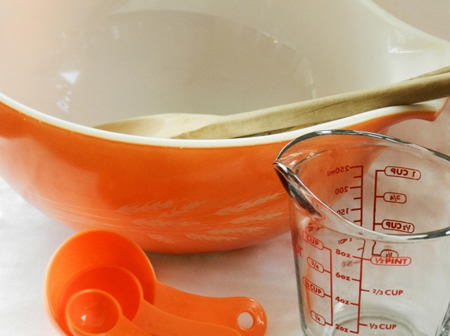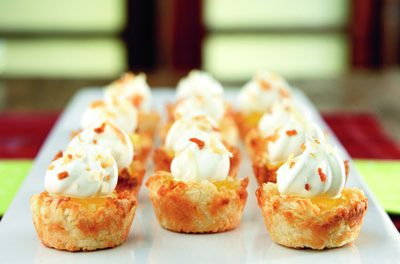How big is big? What is a serving? Why does one serving of salad dressing equal two tablespoons but one helping of cereal fills an eight-ounce cup?
Weights and measures are important concepts for health and nutrition. Although the Food Guide Pyramid, our standard for daily nutritional intake, is based on six categories of foods, equally important is the fact that specific amounts of food are designated in each category. This recommended amount is called a serving and is related to both calories and nutrients.
Sure, you know how much a cup is. Check out your skills anyway. Without measuring, pour out one cup of cereal and one cup of milk. Tests show that most people don't make accurate estimates and measure out a portion larger than a standard single serving. How much is a "pat" of butter? It's only one teaspoon and contains 35 calories. Yet that teaspoon of butter (or margarine) contains about the same number of calories as a medium-sized peach.
While both the Food Guide Pyramid and manufacturers' food labels are based on household measures, serving sizes for both are not always the same. More important is the fact that neither the pyramid's nor the product label's serving size may be the portion size actually consumed. With advertising featuring "all you can eat," "super-size" and "extra value," marketing strategists have led us to believe that more is better and that a large portion is the standard by which others should be measured. This adds to the confusion about what a portion size really is.
Check those labels. Food product labels are a great way to determine what the manufacturer considers to be a portion size. Check labels and expect some surprises. Ramen noodle soups, while marketed as a single-serving product, actually contain two servings per package. Using the entire package for one serving doubles both the calories and sodium per serving. Small pies provide six servings, according to their label. But if you cut the pie into fewer than six servings, calories, fat and sugar per serving are increased.
What counts as one serving? The serving size for meats, poultry and fish portions is based on a 2� to 3 ounce portion. How much is that? A deck of cards is often used as a measure comparison. A pre-cut slice of American cheese is typically one ounce. One egg is one serving. One serving of most cooked vegetables, canned fruits, or fruit juices equals one-half cup, while a serving of leafy salad vegetables is a full cup. Dried fruit is more concentrated, so one-fourth cup is considered a serving. A serving of milk or yogurt is a full eight-ounce cup. Other dairy food portions are sized to provide approximately the same amount of calcium. One serving of bread is about an ounce, or one slice � an average slice, not a Texas-thick slice. A serving of grains like rice, pasta, or cooked cereal measures one-half cup. Dry cereal measures can be quite varied because of differences in weight. A cup of corn flakes or crispy rice weighs one ounce, but heavier cereals like granola or Grape-nuts take only one-fourth cup for the same weight.
Knowing recommended portion sizes helps you make better nutrition choices. You don't have to give up favorite foods if you use serving sizes as a guide to judge what makes a reasonable portion. Choosing foods that contain little sugar or fat allows you a wide variety of foods. Consider a breakfast of one scone. A single 6-oz. scone can contain 600 calories � one-third of an 1800-calorie daily intake. By making careful choices, those 600 calories could offer much more: two English muffins with two teaspoons of jam, one cup of corn flakes eaten with a cup of one-percent milk and a sliced banana, and one-half cup of orange juice. Paying attention to serving sizes and food values can lead to more appealing as well as more nutritious meals.
JoAnn Prophet, MS, RD










